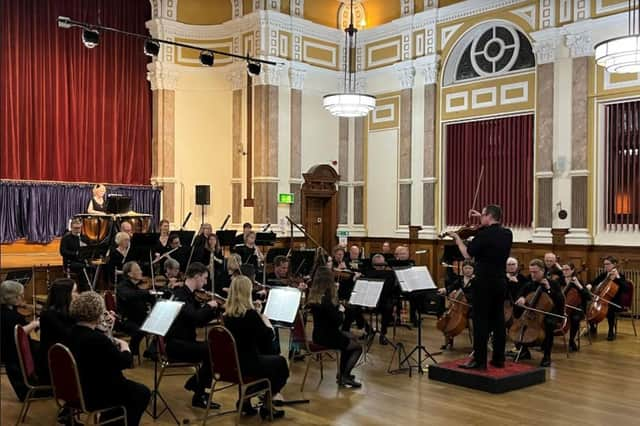Eastbourne Concert Orchestra overcomes Covid adversity


Eastbourne Concert Orchestra’s concert programme on Tuesday 22nd March had been delayed by the pandemic from 2020 – the 250th anniversary of Beethoven’s birth. But the current war in Ukraine gave the programme topical relevance: the ongoing confrontation between tyranny and liberty was expressed musically in the works performed.
Additionally, the ECO’s ebullient conductor, Simon Gower, was indisposed with Covid. Simon had developed the performance of the works by the orchestra during most of the rehearsals. But, at short notice for the performance, the orchestra was directed by its leader, the principal first violin, Simon Smith. Paying tribute to Simon Gower, Simon Smith commented, “The vision for this concert was Simon Gower’s.” The concert was given in Eastbourne’s magnificent Victorian Town Hall, with its recent refurbishments of maroon blinds and mustard and gamboge ceiling panels. The concert was attended by a full audience, including The Worshipful the Mayor of Eastbourne, Councillor Pat Rodohan.
Advertisement
Hide AdAdvertisement
Hide AdThe final work of the concert was Beethoven’s Symphony No. 5. The celebrated opening four-note "short-short-short-long" motif commanded the audience’s attention. The four-note motif was overlapped between the string sections to build longer passages, before the horns announced a more lyrical melody. Towards the end, the oboe had a plangent solo passage in quasi-improvisatory style before the movement ended with decisive chords.
The viola and cello sections began the slow second movement with a halting melody, which was elaborated in due course. The clarinets, bassoons, and violins harmonised a second theme before the flute, oboe, and bassoon counterpointed the opening material.
The cellos and basses started the third movement with an air of mystery before the horns trumpeted the main scherzo theme. The trio was rumbustiously introduced by the cello and double bass sections before all players joined in a joyful dance. When the scherzo was reprised, the horn’s theme, now plucked by the strings with interjections from the clarinet and oboe, was transformed into a ghostly march. A long crescendo led directly into the fourth and final movement, which resounded triumphantly when the trombones joined the rest of the orchestra. The movement includes a revolutionary song by Claude Joseph Rouget de Lisle, the composer of the Marseillaise, an expression of Beethoven’s ideal of liberty. Briefly there was a reprise of the ghostly march before Simon Smith whipped up the tempo (as directed by Beethoven) and the players responded, to bring the concert to an exhilarating finish.
The symphony was preceded by Beethoven’s Egmont overture, as part of the incidental music for the 1787 play of the same name by Johann Wolfgang von Goethe. In his music for Egmont, Beethoven expressed his own political philosophy through the exaltation of the heroic sacrifice of a man condemned to death for having taken a valiant stand against oppression. The Overture became an unofficial anthem of the 1956 Hungarian revolution against Russian occupation.
Advertisement
Hide AdAdvertisement
Hide AdThe overture, one of the last works of Beethoven's middle period, was powerfully and expressively played. The strings set an ominous tone of tragedy in the slow introduction with dark and brutal chords. The heroic, but doomed figure of Count Egmont was suggested by the strings with a surging and restless passage before the dark and brutal chords were answered by lyrical woodwind phrases, suggesting the possibility of reprieve. Ultimately, the brutal chords indicated that Count Egmont had met his death, but his spirit lived on through the rousing trumpet fanfares in the closing bars.
The concert began with Brahms’s Academic Festival overture. Brahms, who enjoyed an ironic joke, had created a potpourri of boisterous student drinking songs in a carefully designed structure made to appear loose and episodic, thus representing both the academic and high-spirited aspects of student life in both the melodic materials and the structure of the overture. After the gruff string opening, all sections of the orchestra contributed, including a violin chorale answered by the horns, a trumpet song and woodwind solos, before the percussion added an air of celebration to the majestic ending.
The orchestra’s performance of Max Bruch’s Suite on Russian Themes demonstrated that Russian musical culture was respected before the current barbarous war. Bruch (1838 to 1920) wrote his orchestral Suite on Russian Themes in 1903 to express his interest in folk music. The Eastbourne Concert Orchestra was augmented with a cor anglais, for this work. The suite opened with Cor Anglais solos evoking the open steppes of Russia. It included a ceremonial funeral march with violin solos sweetly played by Simon Smith, followed by an unexpectedly war-like gopak (a fast dance in two) based on the Song of the Volga Boatmen.
Roger Wintle
For the latest breaking news where you live in Sussex, follow us on Twitter @Sussex_World and like us on Facebook @SussexWorldUK
Advertisement
Hide AdAdvertisement
Hide AdHave you read: Exploring the great joys of the South Downs WayHave you read: Titanic The Musical heads to Southampton
Have you read: So many reasons to celebrate as Chichester's Pallant House Gallery marks 40 yearsHave you read: Search begins for 2022 Sussex Young Musician
Advertisement
Hide AdAdvertisement
Hide Ad